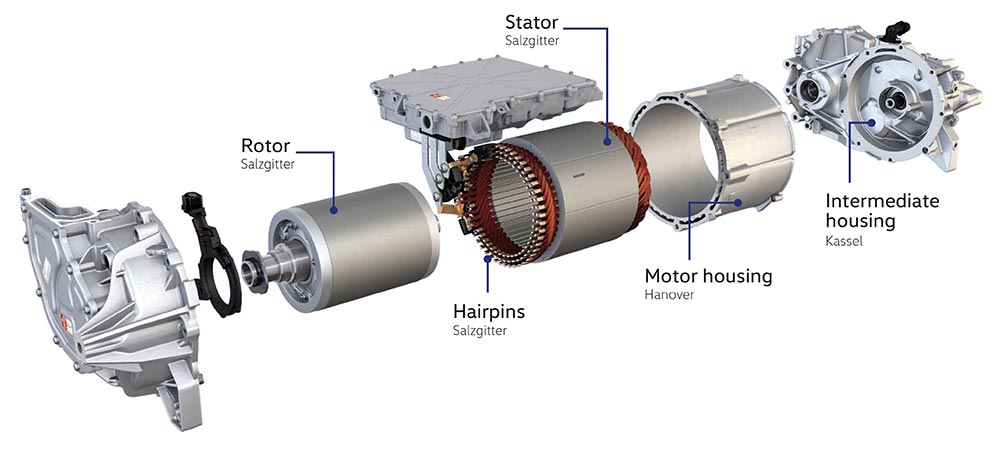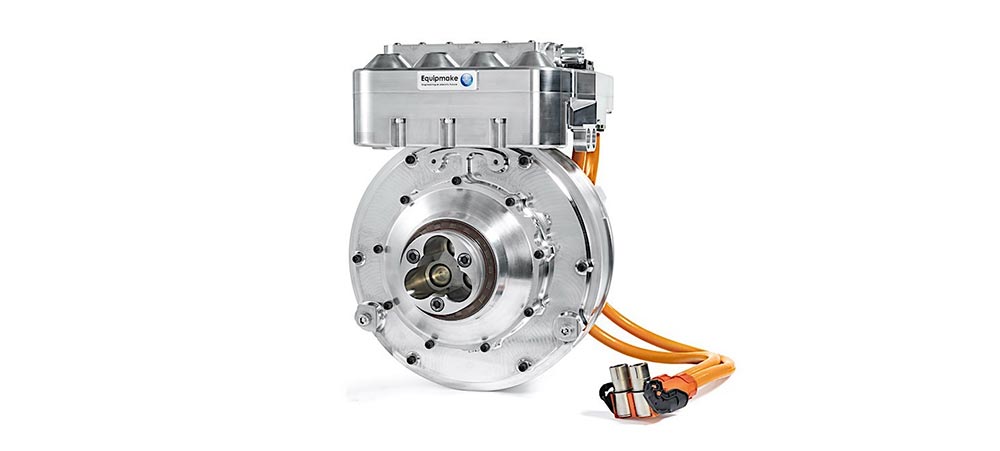 TIM CACHELIN
.
December 20, 2022
.
Electric Vehicle Features
TIM CACHELIN
.
December 20, 2022
.
Electric Vehicle Features

Electric motors may seem complicated, but they don’t have to be. Most electric motors only have one primary moving part, compared to an internal combustion engine with more than 100 moving parts. With this in mind, it is easy to see why electric motors can generate torque so quickly and require virtually no maintenance. Let’s break down how these motors work and the differences between the main types.
There are a variety of motor technologies, brands, and models available for EV builds. Understanding what makes up a complete motor system is helpful in understanding how each motor type works. While there is not one commonly agreed-upon definition of which components fit within a “motor system,” this section explores which components work together in order to provide the required power to the wheels in an EV.

A motor system in an EV typically includes:
Motor or “e-motor”
Inverter
Motor control unit (MCU)
Motor cooling system (temperature sensor, coolant pump, radiator, hose, fittings, etc.)
High voltage cable (#1, #2, 1/0, 2/0, or 4/0 wire)
Wire harness (CANbus, 12v, etc.)
Throttle sensor
Drive mode selector
Brake pressure transducer
Fuse holder
Vehicle control unit (VCU)

Several types of motor technology are available on the market. This technology is constantly evolving to create new and innovative categories of motors. Each motor technology has different benefits and drawbacks. This section will provide a brief overview of each technology before focusing on the working of a specific motor. Some motor systems work slightly differently or integrate multiple systems into one simple unit; these nuances will always be explained in the product information, cut-sheet, or user manual.
All electric motors have a few things in common. First, they use electromagnetism to create rotational motion. This motion is accomplished by one magnetic field in the stator (or the stationary part of the motor), while the other is in the rotor (the rotating part of the motor). To get the motor to spin, one magnetic field must be manipulated through either mechanical or electronic means.
The rotor—and as a result, the motor shaft—will spin to align its magnetic field with the magnetic field of the stator. Since one of these magnetic fields is constantly changing, the rotor will continue to spin.

When a battery or other DC source delivers power to a motor, energy passes from the source to the armature windings on the rotor through the brushes (brushes are metallic and typically located on opposing sides of the motor’s shaft). These brushes carry electric current from the commutator to the armature by physical contact. When the armature coil receives power or energy, it starts to function as a magnet. Its poles then begin to repel the poles of the stator’s permanent magnet. When the poles repel one another, the motor shaft—which the armature coil is connected to—begins to revolve with speed and torque.
Brushes are used to supply electricity to the motor windings via mechanical commutation. However, due to the constant contact with commutators, brushes tend to wear quickly, necessitating regular maintenance and repair.

DC Brushless: Like all electric motors, brushless DC (BLDC) motors function using the same concept of magnetic repulsion and attraction as brush DC motors. However, they are manufactured in a different way. BLDC motors are commonly found in smaller EV applications such as motorcycles or UTVs. They don’t have mechanical brushes and commutators. Instead, they utilize active control circuits to rotate the stator’s magnetic field using electronic commutation, which makes them virtually maintenance-free. Permanent magnets create the magnetic field for the stator.
Many EV makers favor BLDC motors because of their superior efficiency, power density, and ease of maintenance. BLDC motors share much in common with the AC permanent magnet motors, with the difference being how the stator’s electric field is controlled.

AC Synchronous Permanent Magnet: Synchronous motors have rotors that spin at the same rate as the machine’s rotating field. The stator resembles that of an induction motor in that it consists of a tubular iron frame with windings. These windings are powered by three-phase AC voltage placed in slots around the inner circumference. The distinction is in the rotor, which uses permanent magnets that are either embedded in the rotor (internal permanent magnet) or mounted to the surface of the rotor (surface mount permanent magnet) to generate the second magnetic field.
Permanent magnet AC motors are the standard motor construction seen in most EVs today because of their superior power density, ease of maintenance, and lack of torque ripple.
AC Asynchronous Induction: Induction motors use the principle of induction to induce a magnetic field in the rotor of the motor. Electric current in the rotor is obtained by induction from the magnetic field of the stator.
Induction motors are generally less efficient than permanent magnet motors but are often cheaper because they do not require expensive rare-earth magnets. Induction motors are also generally less power-dense than their synchronous permanent magnet counterparts.
On the basis of the direction of the magnetic field, motors are widely divided into two categories: axial flux motors and radial flux motors. In an axial flux motor, the separation between the rotor and stator—and, therefore the direction of magnetic flux between them—is parallel to the axis of rotation.
The axial flux motor is gaining popularity in the e-mobility market due to its high-power density and thin profile. A typical motor’s operation is dependent on the electromagnetic interaction between the magnetic field formed by the magnet and the coil of the structure.
Mass manufacturing moved from the traditional DC power-based brush axial flux motor over to AC and a totally closed brushless design. Instead of a spinning armature, the AC design features fixed coils and dual rotors with permanent magnets, which allow for conversion from DC to AC. These dual permanent magnet rotors allow such motors to have the highest possible torque-to-weight ratio.
Understanding EV Motor Systems Using the Hyper 9 as an Example
The Hyper9 is classified as a Synchronous Reluctance Internal Permanent Magnet Motor (SRIPM). This motor comes in two different variations: High Voltage and Standard. This section will focus on the single shaft High Voltage Hyper 9.
The Hyper 9 motor has been available in the aftermarket EV industry since 2011 and has been utilized in hundreds of builds since then. There is a plethora of information available on the market from consumers who have worked with and installed the motor in their own vehicles. This motor is a great option for any new EV builder, wishing to learn the ropes of EV conversion, or it’s great for any seasoned vet looking to include a reliable and true motor with a small footprint into their build.
To complete the motor system using a Hyper 9, a few additional components are needed.
Motor Control Unit (MCU): The Hyper 9 uses a SME X1 controller to power the motor. This control is similar to an Engine Control Unit (ECU) in an ICE car. It provides the signals to the motor for its operating parameters and is programmed by the builder (or the manufacturer using a clone file).
Inverter: In the Hyper9 system, the inverter is integrated into the MCU, which is quite unusual for an EV but one of the reasons why the Hyper 9 is so popular among builders. The MCU/Inverter combo unit simplifies installation and programming for the end user. Inverters take power from the high voltage DC current battery pack and convert it to usable AC current for the electric motor.
Motor Coolant System: Both inverters and motors can get quite hot when operating under load. While the Hyper 9 itself is air-cooled, its inverter requires a chill plate to maintain safe operating temperature. There is a pump with hose tubes and clamps for pumping coolant to the chill plate, followed by a radiator for cooling the fluid after it has passed through the chill plate.
High Voltage Cable: High voltage cable is always orange in color to signal to builders, repair techs, and first responders that high voltage runs through those lines. High voltage cable will be used to connect any systems that run on the same voltage as the motor.
Wiring Harness: Each MCU/VCU comes with a wiring harness that is used to connect the MCU/VCU to the rest of the systems they need to communicate with (e.g. drive selector switch, throttle sensor, brake pressure transducer, gauges, etc).
Throttle Sensor: The throttle sensor is installed on the existing throttle, or the existing throttle can be replaced with an electric throttle. Either way this sensor will connect to the MCU to communicate the position of the throttle.
The Hyper 9 motor has been available in the aftermarket EV industry since 2011 and has been utilized in hundreds of builds since then.
Driver Mode Selector: The drive mode selector switch is used to tell the motor which direction to spin either propelling the vehicle forward or backward.
Brake Pressure Transducer: The brake pressure transducer is used to communicate the level of brake pedal pressure to the MCU/VCU to send a signal to the motor for regenerative braking. This signal strength can be changed based on the tune and program set by the builder/programmer.
Fuses and Fuse Holders: The fuses in the motor system are special bolt types designed to withstand the high voltage and current demand of the motor. These fuses will blow before allowing dangerous or damaging levels of current or voltage through the system.
Vehicle Control Unit (VCU): Some EVs do not use a VCU, they simply use a collection of networks for each major system that each communicate with each other but do not have a central hub to collect and dispense control signals. The most common hyper 9 system does not utilize a VCU, although there are VCUs available for this purpose.
We use cookies to enhance your browsing experience, serve personalized ads or content, and analyze our traffic. By clicking "Accept All", you consent to our use of cookies. Visit our Cookie Policy for more info.
Notifications
Share Link